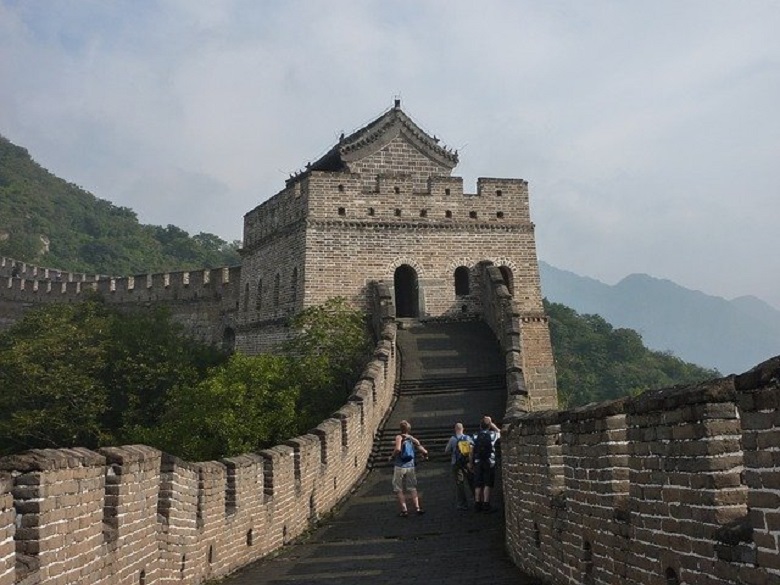It is not surprising that in China, many interesting ancient sights have accumulated over its entire ancient history, which attracts many thousands of tourists every year.
Below we present six of the most famous historical sites that should be visited first. Also, note that all of them were included in the UNESCO list of World Heritage Sites.
1. Great Wall of China: longest fortification in the world

The Great Wall of China is one of the most ambitious landmarks in the world. It began to be erected for defense during the Warring States period (475 – 221 BC), continued during the Qin dynasties (221 – 206 BC), Han (202 BC – 220 AD). BC), northern Wei (386-557), Jin (1115 – 1234), and Ming (1368 – 1644).
In ancient China, the wall was used to protect against invasion by Mongols and Manchus from the north, and today it is a symbol of China, just like Tiananmen Square or the Forbidden City. The wall winds through the mountains for many tens of kilometers, but we recommend visiting its best-preserved sections: Shanhaiguan, Mutianyu, and Jinshanling.
2. Forbidden City: 9999 rooms and 24 emperors
The Forbidden City is one of China’s prominent visited attractions; it is located in Beijing and borders the famous Tiananmen Square. In the Forbidden City, there is a palace, which for many centuries served as the residence of Chinese emperors; “mere mortals” were not allowed to enter here. During the entire existence of the Forbidden City, 24 sovereigns were replaced.
Today, the Imperial Palace is considered the most prominent ancient palace structure globally and embodies all the splendor of traditional Chinese architecture. It houses a huge museum dedicated to the history of China and, of course, to the emperors themselves. In particular, it houses a golden goblet with three columns, which Emperor Qianlong used.
3. Terracotta Army: army of the first emperor
Not far from the splendid mausoleum of the first emperor of China, Qin Shi Huang, there is an unusual museum – its exhibits are figures of soldiers and horses in total growth – a countless army of ancient years skillfully made and buried under the thickness of the centuries. Now it is again open to the eyes of many visitors: about 8 thousand terracotta warriors and horses, 10 thousand pieces of bronze weapons on 22 thousand square meters.
The Terracotta Army claims to be the eighth wonder of the world, and its museum is the largest underground weapons museum in the world. Interestingly, all the soldiers face east – to where the enemy state was in ancient times (475 – 221 BC). Xi’an, home to the Terracotta Army, is one of China’s two most significant ancient cities.
4. Potala Palace: masterpiece of Tibetan architecture
If you are interested in Tibetan culture, then the Potala Palace is undoubtedly the place to visit first. It was built as the residence of Songtsen Gampo (617-650), the founder, and was then rebuilt and from the 17th century became the seat of the Dalai Lama.
The palace itself contains many valuable relics, for example, 10 thousand Buddha figurines made of gold, silver, jade, wood, clay, and the same number of thangkas (scrolls of Buddhist paintings). In addition, there are magnificent murals, wood carvings, and colored paintings used for decoration. All this looks amazingly original.
The Potala Palace is located in the northwestern part of the city of Lhasa. Other most famous sights here are Norbulingka Palace, Jokhang (Tibetan Buddhist temple with more than 1,350 years of history), and Drepung (the most significant monastery globally, about 10 thousand monks).
5. Summer Palace: China’s most extensive imperial garden
The Summer Palace was built on a tracing paper from the West Lake (which is in Hangzhou), which may be why its territory is vast. UNESCO, whose list is in the garden, describes it as a masterpiece of Chinese landscape park art. Natural reservoirs and hills are combined with human-made beauties such as pavilions, palaces, temples, and bridges, forming a harmonious ensemble of exceptional aesthetic value.
During the Qing dynasty (1644 – 1911), Yiheyuan was the summer residence of the emperors; the architects of the Celestial Empire spared no effort and skill to turn this garden into one of the most beautiful and exquisite gardens in the state. Boating is possible on Kunming Lake, and there are many shops and souvenir shops on Suzhou Street, where you can find everything from tea and treats to antiques and silk. It is noteworthy that the vendors on this street are dressed in the style of the Qing Dynasty.
6. Mogao Caves: Land of Buddhist Art
The Mogao Caves are popular for their exquisite murals and Buddha statues. There are 735 caves, 450,000 square meters of murals, 2,415 colored clay statues of Buddha, and more than 50,000 other historical relics. All this makes the Mogao Caves the largest and most significant monument of Buddhist art.
The Mogao Caves began their development in 366, and for 16 dynasties, they accumulated works of Buddhist art. The caves are located near an essential point on the ancient Silk Road – the city of Dunhuang, where you can see a crescent-shaped oasis in the middle of a vast desert.
